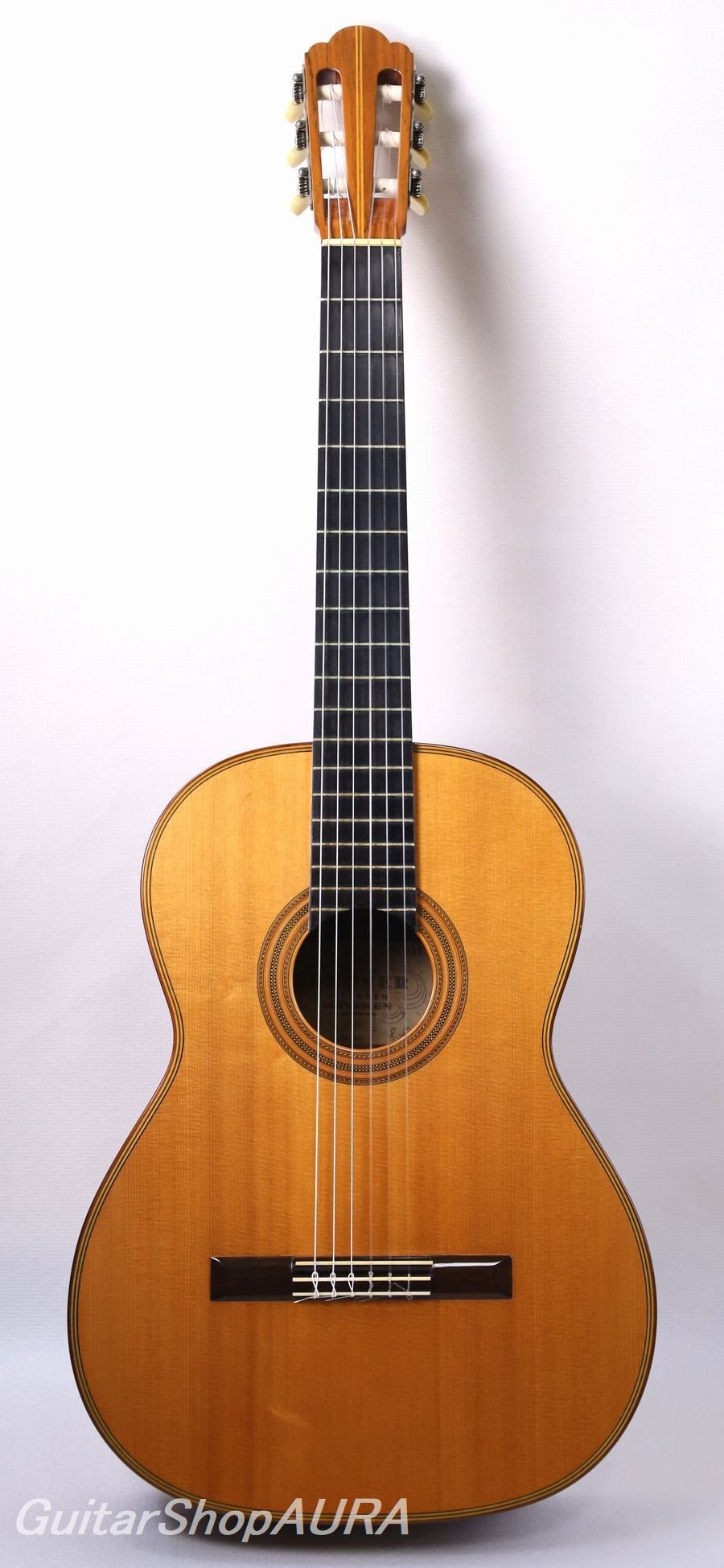
| Instrument | Hermann Hauser II |
| Category | Imported Classical Guitars 〔Vintage〕 |
| Number/Model | Segovia No.935 |
| Scale length | 646mm |
| Country | Germany |
| Year | 1973Year |
| Top | Solid Spruce |
| Side&Back | Solid South American Rosewood |
| Condition※ | 7 |
| List price | INQUIRE |
| Price (tax included) | Please Inquire |
| option | With Hardcase |
Click to enlarge the photos below
Neck:Mahogany
Fingerboard:Ebony
Finish:top/Lacquer、back & sides/Lacquer
Tuning Machine:REISCHEL
String height:1string 2.9 mm/6string 4.1 mm
[Profile]
Hermann Hauser II (1911–1988)
Hauser guitars are undeniably the most celebrated classical guitars from Germany in the 20th century. This distinguished workshop, now in its fourth generation, has maintained its legacy through over a century of masterful guitar making passed down from father to son.
Hermann Hauser I (1882–1952) is renowned for refining his guitar designs based on two iconic instruments: the Antonio Torres guitar owned by Miguel Llobet and the Manuel Ramírez played by Andrés Segovia. His groundbreaking model, later known as the 'Segovia model,' became one of the most important innovations in guitar history since Torres' reforms. It significantly influenced both the construction and performance of classical guitars.
His son, Hermann Hauser II, studied for four years at the violin-making school in Mittenwald, one of Germany's premier centers for string instrument craftsmanship. In 1930, he joined his father's workshop, and together they built guitars—though instruments from this period typically bore the label of Hauser I. Upon his father’s death in 1952, Hauser II officially inherited the workshop and produced his first personally labeled instrument (No. 500). Over the course of his prolific career until his retirement in 1983, he crafted more than 500 guitars.
Like his father, Hauser II developed his guitar-making philosophy through close relationships with great performers such as Segovia, Julian Bream, and Pepe Romero. His instruments reflect a clearer expression of a Germanic tonal aesthetic, resulting in masterpieces with a distinct character compared to his father’s. A standout example is the 1957 guitar favored by Julian Bream, praised for its clarity, balance, and classical elegance—a sound marked by both stoic purity and expressive lyricism.
In the 1970s and beyond, Hauser II demonstrated adaptability and innovation, producing models like the Pepe Romero guitar and exploring new specifications to meet the growing demand. Nonetheless, his 'Segovia' model—faithful to the tradition passed down from his father—remained the pinnacle of his work in terms of craftsmanship and tonal excellence.
Even as modern guitar design trends began to reshape the instrument in the 1980s, Hauser guitars retained their iconic status, continuing to command top value on the global market.
In 1974, Hauser II was joined by his son, Hermann Hauser III (b. 1958), who apprenticed under him for about a decade. Hauser III continues to uphold the family legacy, producing instruments of the highest caliber infused with his own refined aesthetic sensibilities.
[Description]
Hermann Hauser II – 1973 Segovia Model No. 935 (Used)
We are pleased to offer this rare 1973 Hermann Hauser II 'Segovia Model' No. 935. While the exterior maintains the classic design established by Hauser I, the internal structure reflects refinements introduced by Hauser II in the late 1960s.
The bracing pattern consists of one harmonic bar above and one below the soundhole (towards the neck and bridge, respectively), with thin reinforcing plates on either side. The upper bar is straight, while the lower bar features a subtle bend at the center, connecting near the sides slightly toward the neck. The seven fan braces are symmetrically arranged without a closing bar, extending nearly to the bottom of the soundboard. A thin plate reinforces the area beneath the bridge. This unique bracing system—particularly the lack of a traditional closing bar and the bent lower harmonic bar—creates a broader vibrating surface on both bass and treble sides, a concept rarely seen in classical guitar construction. The resonance is tuned slightly below A.
Tonally, this guitar delivers exceptionally fast response with minimal lag between pluck and sound, producing a sound image rich in clarity and elegant luster. Each note has crisp definition, forming lyrical melodic lines with remarkable purity. The relatively high resonance gives the bass a clean, focused character, while allowing the trebles to shine clearly in the foreground. Overall, the instrument sounds bright and lively for a Hauser, while still retaining ample power and a deeply expressive tonal palette—hallmarks of a true classical guitar for the discerning artist.
The guitar retains its original lacquer finish from the time of shipment. Fine lacquer checking (weather cracks) is present across the surface—a natural aging effect inherent to this type of finish and not a cause for concern. Other cosmetic details include minor playing wear, a few small dings, string change marks below the bridge, and some surface scratches on the sides and back from contact with clothing. Given its age, the guitar remains in very good overall condition.
The neck has a slight forward relief, still within standard parameters. Frets show moderate wear in positions 1–7 but do not affect playability. The neck profile is a relatively slim D-shape. String height at the 12th fret is 2.9 mm on the 1st string and 4.1 mm on the 6th, with 1.0–1.5 mm saddle height remaining. Total weight: 1.55 kg.